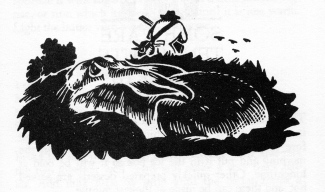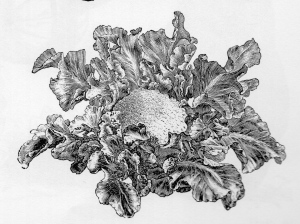A nod to Easter & austerity: Recipes for rabbit (or, if you insist, chicken).
Easter coincides with our second number featuring hardship, war and austerity. In a typical nod to topicality, britishfoodinamerica therefore offers these rabbit recipes to our readers.
Rabbit was one of the few meats other than game and offal that was not rationed in Britain during the Second World War and ensuing age of austerity. If, like many wartime Britons you cannot contemplate dining on Thumper, substitute chicken: These are good recipes that will require only the scant modification that we thoughtfully have provided in their Notes.
Rabbit often is considered to be much like chicken, and as Noted you can adapt most rabbit recipes for use with the bird, but the properties of the two foodstuffs do differ. Rabbit has a more delicate and yet gamier flavor than chicken. It is considerably leaner too, even than free range chickens, and therefore less forgiving to cook. It requires comparatively longer, gentler cooking than chicken and also has fiddlier bones. Unlike chicken’s light and dark, rabbit meat is uniform; it uses the muscles in all of its limbs.
Rabbit boiled with onions. This first recipe for rabbit comes from the eighteenth century via the estimable Jane Grigson; it sounds prosaic but is both foolproof and delicious. It is a springtime staple in the Editor’s house and works equally well with duck. If all you can find is a frozen bunny or bird, then this is an excellent recipe to select; freezing does not harm the final texture of the meat as much as it can when you roast it. Two servings.
 -a rabbit
-a rabbit
-mixed fresh herbs (marjoram, parsley, sage, thyme)
-2-3 lb of big, whole, skinned onions
-salt and pepper
-4 Tablespoons unsalted butter
-4 Tablespoons heavy cream
-a pinch of mace or nutmeg (optional)
- Put the rabbit or duck and onions in a pot just big enough to hold them snugly along with the herbs, salt and pepper.
- “Bring to the boil and simmer until done--this will not take long, if the rabbit or duck is a young one.” The default estimate is just under an hour.
- Meanwhile, however, fish the onions out of the pot once they have softened, usually after about half an hour.
- Drain and chop the onions, then fry them until they turn a pale gold. Stir in the cream and a little of the stock in which the meat has simmered until you have the consistency you like, add the mace or nutmeg if you choose, check the seasoning and sauce the meat either before or after cutting it into servings depending on the presentation you prefer.
Notes:
- Mrs. Grigson served this dish with potatoes and spinach. We like it with peas too.
- If you cannot get fresh herbs use a generous teaspoonful of good dried thyme.
- The quotation in the recipe is from Jane Grigson’s English Food (London 1974) 224. As she also wrote on the same page, this is “[a] favourite eighteenth-century recipe, and a good one.”
- She warns that domesticated rabbit, the only variety available to most Americans, is “too insipid for this kind of treatment,” but we have not found that to be the case.
- Mrs. Grigson’s version of the recipe uses twice as much butter and none of the stock in making the sauce.
- If you use chicken it may take less time to cook. A baseline estimate is about 45 minutes.
Valentine Warner describes a much more involved recipe for Rabbit with Lettuce, Peas and Mint in What To Eat Now (London 2007). It is a good dish, although it can and should be improved with some straightforward modification. The preparation is generally good but the format and language of his recipe are difficult to follow, possibly because it is the transcription of a television presentation straining to sound both helpful to the novice and overly familiar to the viewer.
Warner assumes that his reader (or viewer) is a culinary ignoramus so he offers some needlessly fatuous advice that makes it difficult to track the recipe while cooking. When dusting your rabbit with flour in a plastic bag, for example, “shake it around, making sure that the bag is strong, or as if by magic your rabbit will disappear in a puff of white--onto the floor.” Similarly, “[i]f you put it in a pot that is not hot enough it will sit there miserably,” and yet Warner never actually tells his reader to brown the rabbit over high heat. He could have used a better editor here, for after stating the obvious Warner flubs the lesson. (What 44)
Nonetheless the marriage of these ingredients is both quintessentially English and harmonious if handled properly.
This recipe serves three and may be doubled, as it is in Warner’s version.
 -about 1/3 lb diced slab bacon
-about 1/3 lb diced slab bacon
-2 carrots, peeled and diced
-2 celery stalks, diced
-2 smashed and diced cloves of garlic
-2 diced shallots
-a rabbit cut into 6 pieces
-flour for dusting the rabbit
-salt and pepper
-2 Tablespoons butter
-olive or neutral oil (if needed; see Step 3)
-2 bay leaves
-a pinch of mace or nutmeg
-1 heaped teaspoon dried thyme
-12 oz hard cider
-1 package frozen baby peas
-1 heaped teaspoon (or more) Dijon mustard
-2 Tablespoons cider vinegar
-about 3 cups Romaine lettuce cut crosswise into ½ inch ribbons
-about ½ cup coarsely chopped fresh mint (optional; mintophobes may substitute minced parsley or scallions or a mixture of them).
Preheat the oven to 375°.
- Dust the rabbit pieces in flour generously seasoned with salt and pepper.
- Melt the butter until foaming in a heavy casserole over high heat and brown the rabbit, in batches if necessary: Do not crowd the rabbit or turn it much, or it will not brown.
- Remove the rabbit from the pot and, if the pot is dry, add a little oil. Stir the bacon, carrot, celery, garlic and shallots into the pot, reduce the heat to medium, and cook the dice until they soften, reducing the heat if they begin to scorch.
- Stir the bay, mace or nutmeg and thyme into the dice for a minute, then pour on the cider, add the frozen peas and bring to a boil.
- Return the rabbit to the pot, cover it and put it in the oven.
- After 40 minutes, add the mustard and vinegar.
- After about an hour, check to see whether the rabbit is done; stick a knife in a piece and have a look at the flesh. It should be tender and bloodless.
- When the rabbit is just about barely done, remove it from the oven, uncover the pot and set it on the stove on medium heat. Stir in the lettuce and mint or other greens and cook just until the upper leaves of the lettuce begin to wilt but the stalkside leaves remain crisp.
- Serve with a potato dish of your choice.
Notes:
- Warner allows a cooking time of just over two hours; at least with domesticated rabbit, that is far too long.
- He also uses fresh thyme, which is fine if you prefer; we think it tends to lose its flavor when baked this way.
- Warner also uses canned rather than frozen peas, which in terms of taste and texture are an entirely different vegetable. The choice is yours; at the loss of a very little depth of flavor, the frozen peas provide a fresher compliment to the lettuce without the mustiness of canned peas. Either way the Green Giant ‘LeSueur’ brand, whether frozen or canned, is the best on the American market.
- He uses red wine vinegar too, but we prefer concentrating the apple tones and that is why we use cider vinegar instead.
- Warner lists ‘a handful of mint’ but forgets to add it to the dish in the instructions to the recipe. Some people may consider that serendipitous; opinion in the Editor’s household is split about the addition of mint to anything.
- Chicken is a workable substitute for the rabbit. It is considerably fattier, so the optional dose of oil at Step 3 will not be necessary. Add the mustard and vinegar after 30 minutes at Step 6 and check to see if the chicken is done after 45 minutes; it usually takes less time than the rabbit.
- The rabbit recipes from 500 Sixpenny Recipes by Nora Fletcher (London 1934) are considerably simpler, although she advocates marinating the rabbit in aromatics and white wine or vinegar for several hours in some of them. Mrs. Fletcher also likes to bone the rabbit for a number of dishes, which is sensible given the sharp, splintery dimensions of the smaller bones. Like Warner, she likes to cook her rabbit with lettuce and cider (or beer or white wine), but for Fletcher it is an either/or proposition. An updated version of her Braised Rabbit With Lettuce would go something like this: Cut a rabbit into six pieces and marinate it for 2-3 hours in enough white wine just to cover, along with diced carrot and onion, a few stalks of parsley, two bay leaves, a teaspoon of dried thyme and some whole peppercorns. Cut the rabbit into biggish boneless chunks, dust them lightly with generously seasoned flour (salt, pepper and cayenne) and brown them quickly in a heavy pot with two Tablespoons of foaming unsalted butter over high heat. Get the rabbit out of the pot, reduce the heat to medium and stir the carrot and onion from the marinade with two chopped bacon slices into the pot until the aromatics are barely golden. Deglaze the pot with a little of the wine from the marinade, return the rabbit to the pot with the bay leaves from the marinade, a new teaspoon of thyme, a splash of Worcestershire and enough beef or chicken (or rabbit if you have it) stock to cover. Bring the braise to a boil, cover the pot and bake it in a preheated 350 oven until the meat is nearly tender in about 35-40 minutes. Return the pot to the stove on medium heat and fold in about two cups of Romaine cut into half inch ribbons. Cook until the outer leaves wilt but the stalkier ones remain crisp, check the seasonings and serve hot.
- The Sixpenny Recipe for rabbit casserole is simpler still. Marinate and bone the rabbit as before and fry it in butter over high heat with two chopped shallots until the meat begins to brown but the shallots do not scorch. Sprinkle the rabbit with about two teaspoons of flour, stir the pot until the flour loses its raw color and pour in a cup of good ale or hard cider and enough stock just to cover the meat. Bring to a boil, reduce the heat to very low, cover the pot and simmer until the rabbit is tender but not stringy, about 45 minutes. Meanwhile throw about a cup and a half of sliced mushrooms that you have fried in butter until golden into the pot with the rabbit and ale or cider. Sprinkle the dish with parsley and serve.
- Both of these Sixpenny Recipes serve two.
- To brown mushrooms, always get the butter extremely hot--browned butter is fine--in a shallow skillet over the highest heat you have. To prevent scorching, shake the skillet instead of stirring the mushrooms, which contain a lot of water: All these precautions are intended to prevent the mushrooms from shedding too much of their liquid and boiling to a rubbery state instead of acquiring golden streaks.
Bacon, mushrooms and vinegar often find their way into British rabbit recipes. A simple twentieth century recipe for rabbit pie is another example. It appears in Great British Cooking: A Well Kept Secret by Jane Garmey (New York 1981).
Four servings.
‘Dorothy Ballam’s Poacher’s Pie.’ This is not really a pie at all but rather a stew of concentrated flavor baked in a fairly slow oven under a lid of sliced bacon and potatoes.
 -2 bay leaves
-2 bay leaves
-8 slices of bacon
-3-4 leeks cut into ½ inch discs
-1 lb sliced mushrooms
-a rabbit cut into 8 pieces (split each saddle crosswise)
-salt and pepper
-3 Tablespoons minced parsley
-2-3 baking potatoes (like Idahoes), or enough to cover your casserole, cut into thin discs of about ¼ inch
-mushroom ketchup
-a generous Tablespoon of malt vinegar
Preheat the oven to 325°.
- Put the bay leaves in a heavy casserole and lay 4 of the bacon slices over them, then half of the leeks and half of the mushrooms.
- Put the rabbit on the vegetables in a single layer and top it with layers of the remaining leeks and mushrooms. Season this level generously with salt and pepper, add a splash of mushroom ketchup and strew the whole with 2 Tablespoons of the parsley.
- Arrange the potatoes in a slightly overlapping layer to cover the filling without gaps; sprinkle the remaining parsley over the potatoes, top them with the other 4 slices of bacon and sprinkle the vinegar over the top.
- Tightly cover the casserole and bake it for 2 hours.
- Serve with a lightly dressed salad of… lettuce.
Further notes:
- The absence of stock or other liquid from the recipe is deliberate: The juices from the vegetables moisten the rabbit with their concentrated flavor. As a result, however, you must heed Ms. Garmey’s warning: “Resist the urge to look at the pie while it is cooking as uncovering it will result in a loss of the natural juices.” (Great British Cooking 105)
- Once, long ago and before she knew better, the Editor destroyed this dish by baking it in a reactive pot that resulted in the dreaded pizza delivery. Nothing jolts the palate like a dose of aluminum. Barring such a gaffe, however, this is a good company dish: Foolproof. It is even simpler to make than its description would appear. Besides, you can substitute chicken here too, for the squeamish.
- The mushroom ketchup is our addition, made in the spirit of David Everitt-Matthias’ passion for the essence of flavor.
- A number of traditional British recipes cook lettuce, including some soups, China Chilo and a delicious shrimp dish recorded by Philippa Davenport, while lettuce and peas reappear together in a superb Jane Grigson recipe for boiled duck. We will cover them in a future number of britishfoodinamerica.
- If you substitute chicken for the rabbit, it should not take as long, in this case under an hour an a half.
Meanwhile, another recipe for rabbit appears elsewhere in the practical, in a Note From the Edge (of the Forest of Dean) from Number 1, our Launch Number.
- In the lyrical, our Guest Historian refers to a number of recipes for rabbit, including a fifteenth century one for spiced rabbit from Seven Centuries of English Cooking by Maxime de la Falaise (aka the more prosaic ‘McKendry;’ London 1973). It is suitable if you have leftovers, and not just of rabbit; turkey or chicken work too. The dish has a curious but not unappealing palette, not unlike a weird curry. It is easy to make this Spiced Rabbit from the Age of Exploration. Melt 2 Tablespoons of butter on medium heat and make a white roux by stirring 2 Tablespoons of flour into the butter until the flour no longer looks raw. Stir a cup of chicken or rabbit stock into the roux along with ¼ cup ground blanched almonds, ¼ teaspoon each of ground clove and saffron (or the much cheaper and less assertive ‘Bijol’ powdered condiment), ½ teaspoon each of cinnamon and galangal and a full teaspoon of ground ginger. Cook this sauce until it thickens, then add 2 cups of chopped or shredded boneless cooked rabbit, chicken or turkey. Heat it through. Serve on toast.
- The original recipe is typically Medieval in its incorporation of sugar. We have omitted it because we do not share the premodern enthusiasm for sweetening main course dishes. Incidentally, the original name of the recipe is the rather charming if somewhat hallucinatory ‘Conyngys in Graveye.’
- Galangal, spelled variously ‘Galingale,’ ‘galanggal’ and ‘Galyngale,’ is a root spice that tastes something like a cross between ginger, horseradish and white pepper. It is a staple of southeast Asian cuisines and was prevalent in Medieval English kitchen manuscripts but has fallen from use in Western cooking, proof that notwithstanding our globalizing cultural climate and easy access to exotica, we still may take lessons from the past; the Shakespeare factor. ‘Conimex’ is one brand of dried ground Galangal. It used to be available in the UK from the sadly diminished Culpeper, now redirected in marketing terms from the kitchen to the makeup stand.
- ‘Bijol’ is a mixture of Annatto, cornflour and cumin that is widely available in Latin shops and markets, and in bigger supermarkets in bigger cities in the United States. Substitute turmeric if you live in the UK and refuse to pay the extortionate price of saffron.

